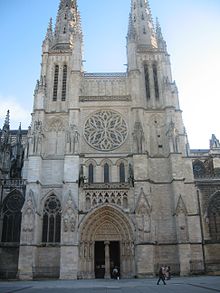Bordeaux Cathedral
The Saint-André Cathedral is a sacred building in Bordeaux (France), which serves as the seat of the Archdiocese of Bordeaux . The cultural monument was classified as Monument historique in 1862 and as such is under monument protection .
description
The Cathedral is 124 m long, 18 m wide in cross House , 23 meters height in the nave and 29 meters height in the chorus of the largest and most important sacral of Bordeaux. The essentially Gothic building (end of the 12th century to the 15th century) was extended by a Romanesque church, of which the western nave is still preserved. The previous building was consecrated in 1096 by Pope Urban II. The weddings of Eleanor of Aquitaine with Louis VII took place in this cathedral in 1137 and that of Louis XIII in 1615 . with Anna of Austria .
The nave is a single-nave hall church, which is astonishing for a building of this size, but is more common in western France (see the cathedrals of Angers and Le Mans). The outer walls are from the Romanesque church, but the vault is from the late Gothic period. Buttresses were added to the sides of the building for the vaulting.
The west facade is completely unadorned and has no portal system. On the north side of the nave is the Gothic king portal built around 1250.
Around 1280, the construction of a new cathedral began with an ambulatory choir with chapels in the form of the northern French Gothic. The transept has double tower facades at both ends, which makes up for the barren western front.
The north portal from the beginning of the 14th century shows a rich sculptural decoration with figures of the archbishops of Bordeaux. It is surmounted by two 81-meter-high towers with pointed, Gothic tower tops. The Gothic building was finished around 1350, and a new building of the nave was evidently not intended.
In the 15th century, the north transverse house rose got a new flamboyant tracery, while the south transverse house rose retained the tracery from the 14th century.
During the French Revolution , the interior was destroyed and the cathedral itself was converted into a barn.
The cathedral has been on the UNESCO World Heritage List since 1998 as part of the “ Camino de Santiago in France” .
In front of the choir on the south side is the isolated bell tower Tour Pey-Berland , which dates from the years 1440-66 and is named after the Bishop Pey-Berland . In 1863 the 50 meter high tower was raised by the statue of Our Lady of Aquitaine .
Tomb of Cardinal de Cheverus
organ
The history of the organs in Saint André can be traced back to the 15th century: The first verifiable instrument was built in 1427 by the organ builder Jacques de Rasta. The instrument was restored at the beginning and end of the 17th century. In the course of the French Revolution, the instrument was sold along with much of the church's equipment; the pipes were partly melted down for the purpose of making uniform buttons. Only the organ case from the 16th century was preserved.
In 1804 the organ of the St. Pierre church from La Réole, which was built in 1766 by the organ builder Jean-Baptiste Micot (Toulouse), was installed in Saint André. However, this instrument quickly proved to be insufficient for the church interior and was dismantled again in 1810. In the course of an instrument exchange (the respective cases remained in their original places), the Micot organ was installed in the church of Sainte-Croix in Bordeaux, and the instrument that had been there until then was installed in Saint André. It was an organ that was built in 1748 by the organ builder Dom Bedos de Celles with 44 stops on four manuals and pedal . In the course of the installation in Saint André, the historical housing had to be enlarged; further registers were added or replaced; Furthermore, the manual range has been extended by 3 tones. The construction in the cathedral lasted from 1812 to 1817.
In the middle of the 20th century the organ had 56 registers, of which only 26 still came from the original instrument by Dom Bedos de Celles. In the 1970s it was decided to return the Dom Bedos organ to its original location in the Sainte-Croix church and to build a new instrument in Saint André. The new instrument was built by the organ builder Danion-Gonzalez . It has 76 stops on four manuals and a pedal. The Spieltrakturen are electro-pneumatic, the Registertrakturen electric.
|
|
|
|
|
||||||||||||||||||||||||||||||||||||||||||||||||||||||||||||||||||||||||||||||||||||||||||||||||||||||||||||||||||||||||||||||||||||||||||||||||||||||||||||||
- Coupling: I / II, III / II, IV / II, III / I, IV / I, I / P, II / P, III / P, IV / P, I – IV / P
Individual evidence
Web links
- Bordeaux Cathedral (French / Spanish)
Coordinates: 44 ° 50 ′ 15.6 " N , 0 ° 34 ′ 39.2" W.













